Tibetan Ritual or Sacred Arts
The nuns at two Tibetan Buddhist nunneries in northern India are learning and practicing many of the sacred arts of Tibet. In this blog post, we will show you some of those ritual arts including making butter sculptures, making tormas, and playing traditional Tibetan musical instruments.
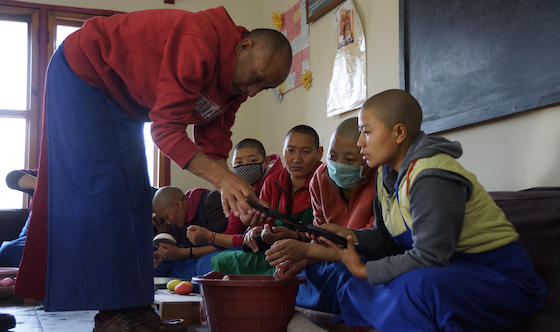
Gen Karma la teaches nuns at Dolma Ling the Tibetan sacred art of butter sculpture. Photo by the Dolma Ling Media Nuns.
Most of the nuns we support in India are Tibetan refugees who fled their homeland seeking freedom to live, study, practice, and teach in accordance with their spiritual beliefs. In addition, the Tibetan Nuns Project helps nuns and nunneries following the Tibetan Buddhist tradition in Buddhist communities in Indian Himalayas, such as Kinnaur, Spiti, Ladakh, and Zanskar.
Nunneries and monasteries are not only places of worship and religious training, they are also the preservers of tradition and the sacred arts.
Tibetan Butter Sculpture
The highly revered artistic tradition of making Tibetan butter sculptures has been practiced for over 400 years in Tibet. The art of making Tibetan butter sculptures is now being preserved by monks and nuns living in India as refugees.
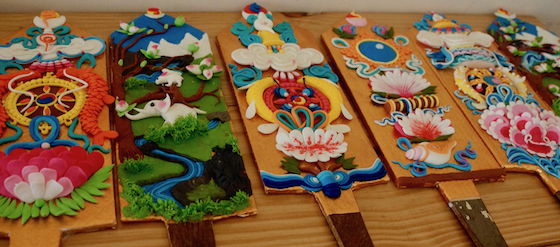
At Losar, Tibetan New Year, the nuns at Dolma Ling create hundreds of butter sculptures including these tsepdro with individual designs including the eight auspicious symbols, the four harmonious friends – elephant, monkey, rabbit, and bird – and the sun and the moon. Photo by the Dolma Ling Media Nuns.
Tibetan butter sculptures made with colored butter are used as offerings and for elaborate rituals and celebrations. Losar, or Tibetan New Year, is a very special time for the making and displaying of Tibetan butter sculptures.
Since 2001, the Tibetan Buddhist nuns at Dolma Ling Nunnery and Institute in northern India have been studying this ancient art with their teacher, Gen Karma la. In addition to the larger butter sculptures made for the Losar altar, the nuns make smaller displays on individual sticks, called tsepdro, for each person in the nunnery — nuns, staff, and teachers. This means that each Losar, the nuns make around 300 of these, using a wide variety of designs. The nuns display them in their rooms as part of their Losar altars and offerings, as a kind of bundle of auspiciousness.
Butter has always been highly valued in Tibetan culture. Its availability and its malleable quality in the cold climate of the Tibetan plateau and the Himalayas made it an ideal material for sculpting. Inside Tibet, the sacred Tibetan butter sculptures would be made from the butter of dri which are female yaks.
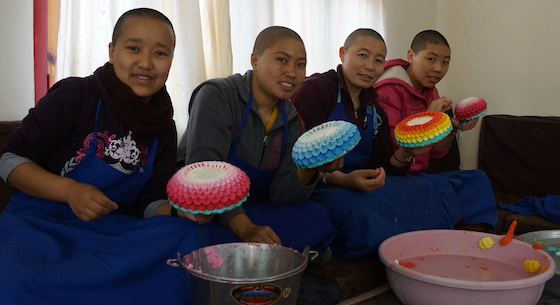
It is the practice in Buddhism to offer flowers as a tribute to Buddha statues on altars. However, in winter when no fresh flowers can be found, flowers sculpted from butter are made as an offering. Photo by the Dolma Ling Media Nuns
Making butter sculptures requires painstaking skill, learned from an excellent teacher and through years of practice. Like the famous Tibetan sand mandalas, butter sculptures are a unique Tibetan sacred art that has been handed down for centuries from teacher to student.
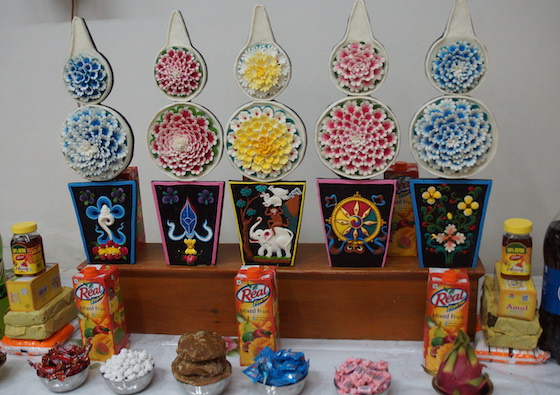
Elaborate butter sculpture flowers and sacred symbols made by the nuns decorate the altar for Losar, Tibetan New Year. Photo by the Dolma Ling Media Nuns.
The increasing shortage of well-trained and skilled butter sculptors in Tibet means that it is crucial that in India the nuns learn this religious art as part of their course of studies in order to keep it from dying out.
Tormas
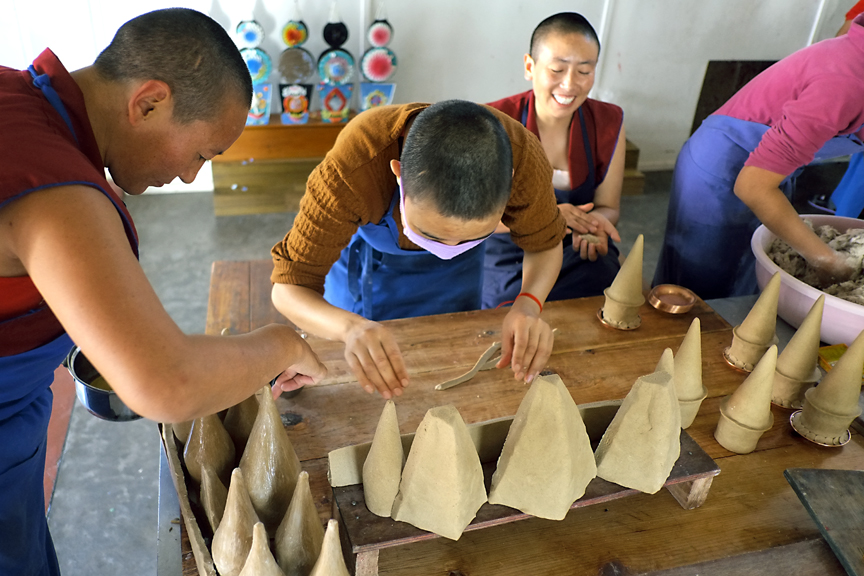
Tibetan Buddhist nuns at Dolma Ling make tormas out of flour and butter. Photo courtesy of Brian Harris.
Tormas are figures used as offerings in Tibetan Buddhism or as part of tantric rituals. Made mostly of flour and butter, tormas are usually conical in shape but are also made in other shapes depending on their purpose. They are sometimes dyed, often with white or red for the main body of the torma. Typically, tormas are small and placed directly on a plate or on shrines.
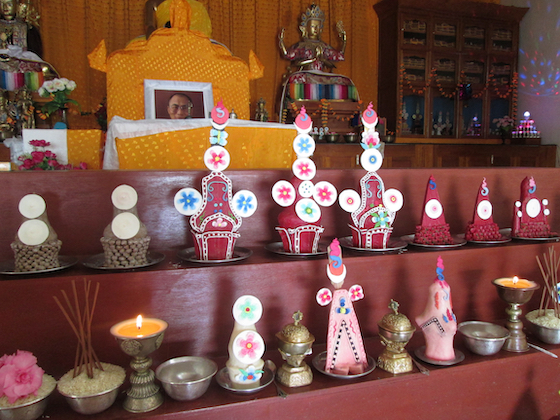
Elaborate tormas of different sizes, shapes, colors, and decorated with butter are arranged on the altar for the special Chod puja at Shugsep Nunnery and Institute. Chöd is a spiritual practice that aims to cut through ego and ignorance, obstacles on the path to enlightenment.
Tibetan Ritual Music Instruments
Tibetan ritual music like this audio recording of the Tara puja (prayer ceremony) at Dolma Ling Nunnery and Institute may surprise people who are not familiar with Tibetan Buddhism. Group chanting is accompanied by a variety of specialized Tibetan instruments and this can be very dramatic and loud. Ritual music is a form of offering.
The musical instruments used in pujas fall into two broad categories: percussion instruments and wind instruments.

Tibetan Buddhist nun playing cymbals during puja Photo by Brian Harris
Here are some of the sacred Tibetan instruments that the nuns play during pujas:
1. Various types of brass cymbals provide structure and rhythm during group chanting.
2. Various kinds of drums including hand drums and a large drum mounted on a special stand often used to mark the time during group practice.
3. A Tibetan wind instrument called gyaling (meaning Indian trumpet) a reed instrument, somewhat like an oboe.
4. Another type of Tibetan wind instrument called a kangling, an ancient instrument from India that was historically made of a human thighbone, and often used in rituals regarding wrathful deities.
5. Conch shells which when blown have a deep, resounding tone. They are also used to announce the arrival of important figures or to call monastics to assemble for prayers.
6. Perhaps the most remarkable of all, the dungchen, a long trumpet with a deep, low sound that has been compared to the trumpeting of an elephant. Most dungchen are made of telescoping sections and are elaborately decorated with metalwork. Dungchen are played to welcome high lamas and Rinpoches to a monastery or temple.
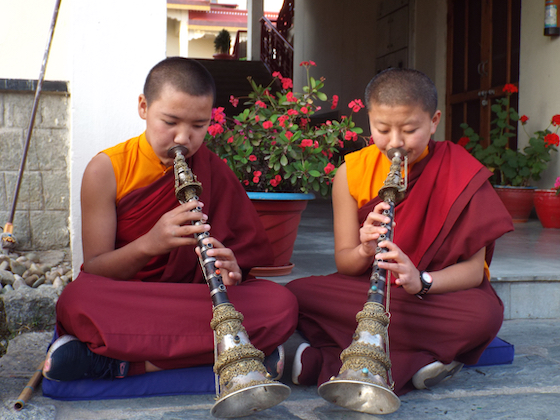
Two nuns from Shugsep Nunnery and Institute playing the gyaling, a Tibetan wind instrument somewhat like an oboe. Photo by the Media Nuns.
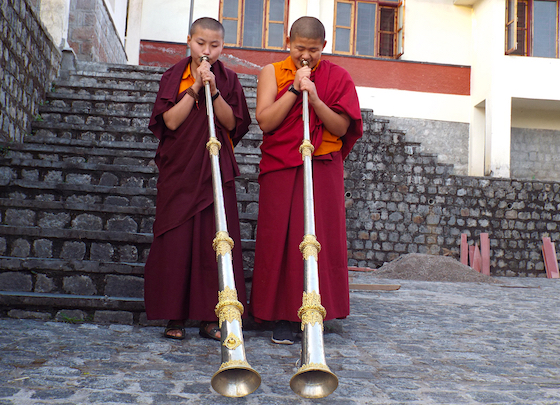
Nuns playing dungchen, long trumpets with a deep, low sound used to are played to welcome high lamas and Rinpoches to a monastery or temple. Photo by the Media Nuns.
